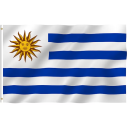 Tasting No 259 November 28 (previously 14), 2023 12:30pm
Tasting No 259 November 28 (previously 14), 2023 12:30pm
Wines of Canelones, Uruguay
-
Tasting Overview
The Canelones wine region of Uruguay may be one of the lesser-known gems in the world of wine, but its growing recognition is well-deserved. With its unique terroir, diverse grape varieties, innovative viticulture practices, and unique maritime influence, Canelones is in the forefront of the Uruguayan wine industry. In this tasting, we’ll explore the Canelones wine region of Uruguay, delving into its history, climate, grape varieties, and the thriving wine culture that has emerged in recent years.
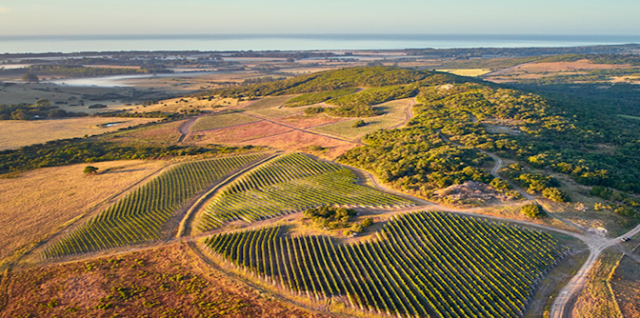 Type of tasting: Open
Type of tasting: Open
Presenter: Michelle Fryer
Participants: R. Arroio; M. Averbug; L. Boccalandro; J. Brakarz; C. Estrada; M. Fryer; J. Garcia; N. Marzella; C. Perazza; L. and J. Redwood; R. Santiago; E. Silva; G. Smart; P. Turina; L. Uechi and P. Meduña (invited).
These are the Wines:
- Bouza ‘Albarino’, 2022
- Pizzorno ‘Tannat Maceración Carbónica’, 2020
- Bouza ‘Tannat,’ 2019
- Bouza ‘Tannat A6 Parcela Unica’, 2018
The Menu:
- Calamare sauteed in lemon sauce
- Spaghetti Carbonara
- Grilled NY Steak with Spinach and brown sauce on the side
- Dessert, coffee, tea.
-
The Canelones Wine Region
Uruguay, often overshadowed by its wine-producing neighbors, Argentina and Chile, is the fourth-largest wine-producing country in South America. The Canelones wine region, located in the southern part of the country, is the epicenter of the country’s wine production and has been steadily gaining recognition for its exceptional wines. Nestled between the Atlantic Ocean and the capital city of Montevideo, Canelones is a region characterized by a temperate maritime climate, rolling hills, and fertile soils that provide an ideal environment for producing world-class wines.

History and Terroir. The Canelones wine region is Uruguay’s oldest and most prominent wine-producing area. Wine grapes have grown here for over 250 years, although commercial viniculture did not begin until the second half of the 19th Century when a wave of European immigrants brought rootstock and vines of different varietals to the country. The original transplants of Tannat were called “Harriague” in honor of the French Basque settler who introduced the varietal. Over the past few decades Uruguayan wine has emerged quietly and steadily onto the world market. In the past, most of the wine was table wine, produced mainly for the domestic market; but from the year 2000 onward, the consumption of table wine has declined year after year, and the production and consumption of high-quality wine has increased. Currently Uruguay is the fourth-largest wine-producing country in South America, however a relatively small share (10%) of its wine is exported.
Canelones is responsible for 60% of the country’s wine production. It is therefore not only the epicenter of the Uruguayan wine industry, but for Tannat as well, with more of the variety planted within the department than anywhere else on Earth. The region owes its success to the combination of favorable climatic conditions, exceptional terroir, and a long growing season with ample sunlight, making it well-suited for the slow ripening of the fruit. It benefits from the temperate maritime climate which is characterized by cool breezes and a significant temperature range between day and night — both essential for the development of complex flavors in the grapes. Proximity to the Atlantic Ocean also results in refreshing acidity and mineral notes in white wines, and a softer tannin structure in red wines. Likewise, the Atlantic breeze plays a role in reducing the risk of pests and diseases in the vineyards; and the thick skin of the Tannat grape is impervious to the mildew that so readily affects more delicate varieties, allowing for sustainable and organic farming practices.
One of the most interesting assets of Uruguay is the wide diversity of soils. Uruguay has 99 classified soil types. The lengthy coastline on three sides of the country moderates the temperature and the absence of mountains exposes the landscape to weathering and erosion that has resulted in a relatively flat topography and formulated a variety of soil types throughout the country. The viticultural areas of the south have the deepest, most fertile soils. The Canelones region is characterized by diverse terroirs, including clay-rich soils, limestone, and sandy loam. The presence of volcanic rock and weathered granite helps to promote drainage. These varied soil types, along with the maritime influence and microclimates, allow winemakers to craft a wide spectrum of wines, from elegant and fruit-forward to structured and powerful.
The grape varietals: No summary of Uruguayan wine is complete without mention of Tannat, the robust, tannic red that has played such a pivotal role in the country’s rising wine status. Just as Chile has its Carmenere and Argentina its Malbec, so Tannat has become Uruguay’s ‘icon’ grape.
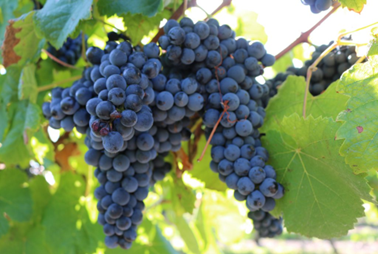 Tannat was originally known for its harsh tannins, high acidity and dark fruit that was nearly undrinkable upon release, but in Uruguay, vintners have found methods to soften the tannins and create powerful wines that taste of plums and blackberries. In addition to these fruit flavors, Tannat, when blended with other varieties, or produced in capable winemaking hands, tends to show off more complex notes of herbs, chocolate, leather, earth, and minerals.
Tannat was originally known for its harsh tannins, high acidity and dark fruit that was nearly undrinkable upon release, but in Uruguay, vintners have found methods to soften the tannins and create powerful wines that taste of plums and blackberries. In addition to these fruit flavors, Tannat, when blended with other varieties, or produced in capable winemaking hands, tends to show off more complex notes of herbs, chocolate, leather, earth, and minerals.
Originally from southwest France, Tennat has found a second home in Uruguay and accounts for some 27 percent of the country’s plantings. The grape needs some humidity to balance its tannin, sugar, and acidity, otherwise, the sugars accumulate before the skin ripens; hence it thrives in the country’s favorable maritime climate, producing wines with intense dark red, bluish, and almost black color, often with violet reflections; and aromas of ripe dark fruits, tobacco, and earthy undertones. In the best varietal examples, the tannins are strong but supple. These wines are often characterized by their robust structure and longevity, making them a unique representation of the region as a single varietal or in interesting blends.
While Tannat takes the lead, winemakers in the region have also started experimenting with other grape varieties, resulting in a growing portfolio of varietals that include Albariño, Sauvignon Blanc, and Syrah. These grapes add diversity to the region’s wine offerings, catering to a broader range of palates.
 Wineries and Viticulture. Canelones is home to some 900 vineyards, many of which are family owned. These wineries often emphasize sustainable and organic practices, contributing to the region’s reputation for producing environmentally conscious wines. Larger commercial operations and boutique producers also contribute to the region’s dynamic winemaking landscape. Nonetheless, until recently, the world has taken little notice of Uruguayan wine. Very little is exported (up to 10% nationally) and winemaking is largely focused on the domestic market. In contrast to Argentina and Chile, Uruguay has few internationally recognized successes. Top producers such as Bodega Bouza, Garzon, Juanicó, and Pizzorno are newcomers in the international wine scene. These winemakers are investing in better equipment and technology and are known for their distinct winemaking styles and top-quality wines. As a result of better quality, the exports of these producers have increased. Bouza now exports 60% of its production, and Garzon ships out 73%, mainly to the United States.
Wineries and Viticulture. Canelones is home to some 900 vineyards, many of which are family owned. These wineries often emphasize sustainable and organic practices, contributing to the region’s reputation for producing environmentally conscious wines. Larger commercial operations and boutique producers also contribute to the region’s dynamic winemaking landscape. Nonetheless, until recently, the world has taken little notice of Uruguayan wine. Very little is exported (up to 10% nationally) and winemaking is largely focused on the domestic market. In contrast to Argentina and Chile, Uruguay has few internationally recognized successes. Top producers such as Bodega Bouza, Garzon, Juanicó, and Pizzorno are newcomers in the international wine scene. These winemakers are investing in better equipment and technology and are known for their distinct winemaking styles and top-quality wines. As a result of better quality, the exports of these producers have increased. Bouza now exports 60% of its production, and Garzon ships out 73%, mainly to the United States.
-
The Wines
Wine #1. Pizzorno Capital, ‘Tannat Maceración Carbónica’, 2020
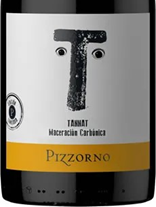 Producer: Pizzorno Family Estates. Established in 1910, Pizzorno is a key producer in Canelones. Pizzorno’s mission is to produce “grapes of excellent quality, to obtain fine wines in limited series – the result of an acquired winemaking style that combines art and technology”. The winery has one of the most innovative portfolios in the region with Uruguay’s first carbonic maceration Tannat wines and ice wines. This fourth-generation family producer may be groundbreaking in their winemaking, but they also respect the century-long tradition of the family wine business. With 21 hectares of vineyards in Canelones, Pizzorno only uses Estate fruit in their wines. Pizzorno’s vineyards are located on a gentle slope with shallow, clay loam soils and calcareous material, and planted with Tannat, Cabernet Sauvignon, Cabernet Franc, Petit Verdot, Merlot, Pinot Noir, Malbec, Arinarnoa, Marselan, Sauvignon Blanc, Chardonnay and Moscatel de Hamburgo. Vineyard management is focused on green harvesting and careful canopy management to achieve full ripeness and the best quality grapes. All the grapes are hand harvested and the winemakers carefully choose the harvest date based on sensorial and chemical analysis of the grapes.
Producer: Pizzorno Family Estates. Established in 1910, Pizzorno is a key producer in Canelones. Pizzorno’s mission is to produce “grapes of excellent quality, to obtain fine wines in limited series – the result of an acquired winemaking style that combines art and technology”. The winery has one of the most innovative portfolios in the region with Uruguay’s first carbonic maceration Tannat wines and ice wines. This fourth-generation family producer may be groundbreaking in their winemaking, but they also respect the century-long tradition of the family wine business. With 21 hectares of vineyards in Canelones, Pizzorno only uses Estate fruit in their wines. Pizzorno’s vineyards are located on a gentle slope with shallow, clay loam soils and calcareous material, and planted with Tannat, Cabernet Sauvignon, Cabernet Franc, Petit Verdot, Merlot, Pinot Noir, Malbec, Arinarnoa, Marselan, Sauvignon Blanc, Chardonnay and Moscatel de Hamburgo. Vineyard management is focused on green harvesting and careful canopy management to achieve full ripeness and the best quality grapes. All the grapes are hand harvested and the winemakers carefully choose the harvest date based on sensorial and chemical analysis of the grapes.
The Wine:
- Vintage: 2020
- Variety: 100% Tannat.
- Vinification: carbonic maceration; aged in bottle for 2 yrs.
- Alcohol 13.5%.
- Press and Points: 91 pts., Tim Atkin; 92 Pts., Descorchados.
Winemaker notes: Bright and fresh because of how it’s made, this wine is lean for a Tannat. Carbonic maceration is an ancient vinification technique that has its origin in Greece and Rome. Carbonic maceration keeps the wine’s fruit flavors extra fresh and intense, with less tannin and overall extraction. It works like this: whole grape clusters are harvested and transported to the winery in 10kg boxes to preserve the integrity of the grape. The grape clusters are next placed in a large concrete tank that is sealed for 20 days. The grapes on the bottom get crushed under the weight of those above them, and they start to ferment naturally from the yeast on the skins. As CO2 is released, it pushes out oxygen and keeps the grapes fresh. Eventually, so much CO2 builds up that the rest of the grapes’ skins burst. Hence, carbonic maceration! Pizzorno is the only commercial winery to process the Tannat grape this way. This technique produces a lively, juicy, and subtly herbaceous wine which has a soft palate due to decreased acidity, while increasing the extraction of aromas. Following the fermentation process, the wine is parked in the bottle for 2 years.
Tasting notes: light ruby color with violet reflections and medium intensity. Red fruits such as raspberry or cherry and banana on the nose. On the mouth, balanced, smooth, balanced acidity, low intensity of tannins.
Wine #2. Bouza ‘Albarino’ 2022
Producer: Bodega Bouza. Without a doubt, the leading winery for tourism in this region is Bouza. The Bouza family are true visionaries. They pioneered fine wines in Uruguay, were the first to plant Albariño there, and opened Uruguay’s first fine-dining winery restaurant.
Juan and Eliza Bouza are relatively new to the wine industry, having co-founded the project with renowned Uruguayan winemaker Eduardo Boido in 2000. From the very beginning, Bouza has focused on making premium wines and over the last ten years has established itself as Uruguay’s most critically acclaimed producer.
What’s interesting about Bouza’s story is how, even as new producers, they looked to their ancestors to pave their path in wine. Coming from families of Galician descent, and with some extended family still in Rias Baixas, they asked their family for Galician vines and planted Albariño in Canelones and Montevideo in 2001. This rather inspired move saw them not only make the first Albariño wines in South America, but ignite an important Albariño movement in Uruguay, which is undoubtedly the rising star of Uruguay’s white wines.
The success of Bouza’s Albariño has also encouraged the winery to expand farther afield, planting new vineyards in the rare syenite soils of Pan de Azúcar, and a hilltop vineyard on poor, volcanic soils in Las Espinas in the Maldonado region. But for now, the lion’s share of Bouza’s wines still comes from the traditional wine regions of Canelones and Montevideo, where they have three vineyards, including their prized vineyard in Las Violetas.
To increase biodiversity and reinforce the balance between pests and their natural enemies, Bouza alternates grapes with rows of plant cover composed of herbs characteristic of the Uruguayan natural meadow. The harvest begins in early February with the Pinot Noir variety, followed by our white varieties Albariño, Chardonnay and Riesling; then continues with the Merlot and Tempranillo tints, usually ending in mid-March with the emblematic variety of Uruguay, Tannat.
- Vintage: 2022
- Variety: 100% Albarino
- Appellation: Canelones
- Vinification: 90% fermented in stainless steel tanks and 10% in French Oak barrels; aged 4 months over its lees; unfiltered,
- Alcohol 13.5%.
- Points and Press: 92 Points, James Suckling; 92 Points, Tim Atkin; 95 Points, Descorchados.
Winemaker notes: If you take Rias Baixas in Galicia, Spain – where this grape is from – and transposed it west and south to the coast of South America, you’d end up in Uruguay! For this reason, Albariño does well there. This Albarino is super fresh, with minerals adding extra waxiness in the mid-palate. Gala apple and salinity are the two flavors that define this wine. The recommended serving temperature is 54oF.
Tasting notes: Pale yellow color, with golden highlights. Aromas of peach and white flowers, pineapple, and pear. Moving the glass, pineapple enhances its presence, vanilla and caramel appear. Sweet entrance in the mouth with a slow evolution and a balanced acidity. Long finish.
Wine #3. Bouza Tannat 2019

- Vintage: 2019
- Variety: 100% Tannat
- Viticulture: Grapes are sourced from three maritime influenced sites: Melilla, a fairly cool climate site that surrounds the winery; Las Violetas, a warmer, clay driven site; and Pan de Azucar.
- Vinification: fermented for 12 days at 79oF degrees in steel tanks, then aged for 16 months in French and American oak barrels.
- Appellation: Canelones
- Alcohol 14.5%.
- Points and Press: 93 Points, James Suckling; 93 Points, Uncorked.
Winemaker notes: Tannat literally means “Tannic,” but not as a warning. Instead, it signals that wines made from this grape will have a distinctly textural expression, giving the wine more contour and size. Wild dark fruits abound, and the wine also sees oak, adding herbal notes and smoothing the tannins. James Suckling observed that this wine is a “complex, engaging expression of Tannat, showing dark, meaty fruit, black spices, some black earth, tar and hints of cocoa powder and oyster sauce. Medium-to full-bodied and juicy with fine-grained tannins and a lengthy finish. Showing power, natural concentration and good precision.” The grapes were grown in the clay and limestone soils of the Melilla and Las Violetas vineyards and handpicked between March 6-18, 2019. The recommended serving temperature is 60o F.
Tasting notes: Intense red color. Fruit aromas include raspberry and blackberry. Notes of quince and tobacco. Balanced acidity, good volume, and present tannins. Very long finish. Garnet red color with petrol highlights. Very expressive in the nose with black fruits, mulberries, cassis, raisins, over an elegant smoky background. Velvety but marked tannins. Balanced and persistent final bouquet.
Wine # 4. Bouza ‘Tannat A6 Parcela Unica’, 2018
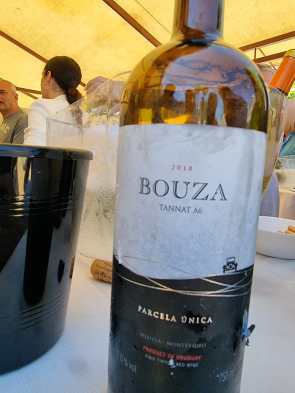
- Vintage:2018
- Variety: 100% Tannat
- Appellation: Canelones
- Viticulture: Grapes sourced from single parcel in Melilla. Dry farmed for maximum depth of flavor in the finished wine.
- Vinification: Manual selection of the grapes. Controlled fermentation at 26oC, with 2 pump overs and 1 pipeage a day. Total maceration 12 days. 17 months in new French and American oak barrels.
- Alcohol: 16%.
- Points and Press: 90 Wine Enthusiast, 93 points Descorchados
Winemaker notes: This wine is a single parcel Tannat that Bouza considers one of its masterpieces. The quality of fruit here is exceptional, but it’s the tannins and overall texture of the wine that’s sublime. According to Vivino, the wine is currently the #1 “top Uruguay Tannat wine in the United States.” Sourced from Melilla, the relatively cool-climate vineyard that surrounds the winery, planted rows are uniquely topped with two feet of pink granite from a local quarry to collect and radiate additional heat for these grapes. This bottling showcases the savory/smoky/earthy side of Tannat, and is one of the richest, balanced, most memorable examples of single-vineyard Tannat produced in Uruguay. Wine Enthusiast notes that… “coffee and black fruit aromas shape the nose and lead to flavors of grass and plum. Oak flavors are slightly intense but well integrated. It has a full body, smooth tannins, and a long finish with hints of black olive and nutmeg”. It can be conserved for 12-15 years. The recommended serving temperature is between 16-18o C.
Tasting notes: Intense purple color. Plum raisins aroma. Quince marmalade and toasted notes. Balanced mouth, with big volume and smooth tannins. Long finish.
- CV Members rating:
The tasting took place before revealing the wines’ prices. Fifteen participants rated them from Acceptable to Exceptional. The combined results established the preference order during the tasting.
Bouza ‘Tannat’, 2019 was rated the Best Wine and the Best Buy. The following Table presents the details of individual ratings and combined results.
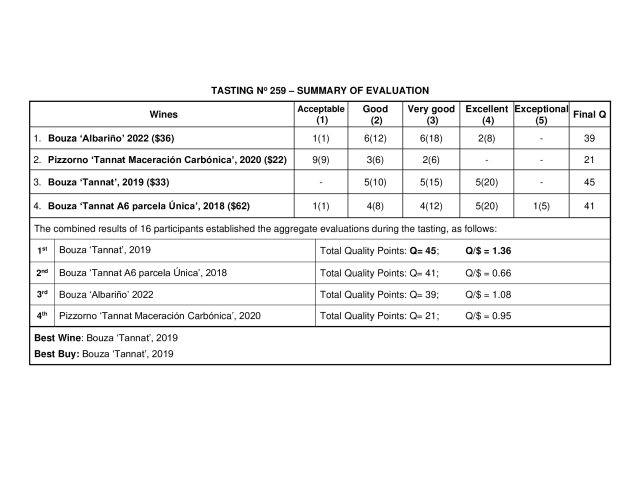
This post draws heavily on these sources:
https://www.wine-searcher.com/regions-uruguay
https://bodegabouza.com/vinedos/
https://www.grandcata.com/home
https://southamericawineguide.com/wp-content/uploads/2021/10/SAWG_mapas-Uruguay-Page-2.jpg
Uruguay: The Little Wine Country that Could. March 11,2022/updated June 2023. https://worldoffinewine.com/news-features/uruguay-the-little-wine-country-that-could#:~:text=Uruguay%27s%20wine%20regions-,Canelones,most%20populous%20city%20of%20Uruguay.
Team Haverkate. Uruguay’s Wine Regions: Exploring the Country’s Vineyard. https://www.realestate-in-uruguay.com/blog/uruguays-wine-regions-exploring-the-countrys-vineyard/
Amanda Barnes. Canelones: The Heartland of Uruguayan Wine. July 2016. https://aroundtheworldin80harvests.com/2016/07/19/uruguayan-wine-uruguay-canelones/
The Most Spectacular Winery Restaurants in South America. September 2023. https://cluboenologique.com/story/best-south-american-winery-restaurants/
Zraly, M. DeSimone & J. Jenssen. Red Wine: The Comprehensive Guide to the 50 Essential Varieties and Styles. New York: Sterling Epicure. 2017.
Taming the Tannat: Uruguayan Wine Gets a Makeover. June 2021. https://www.jamessuckling.com/wine-tasting-reports/taming-the-tannat-uruguayan-wine-gets-makeover/
.o0o.

The world’s problems began when white-striped zebras began to hate black-striped zebras.
Os problemas do mundo começaram quando as zebras de listras brancas começaram a odiar as zebras de listras pretas.
.o0o.

